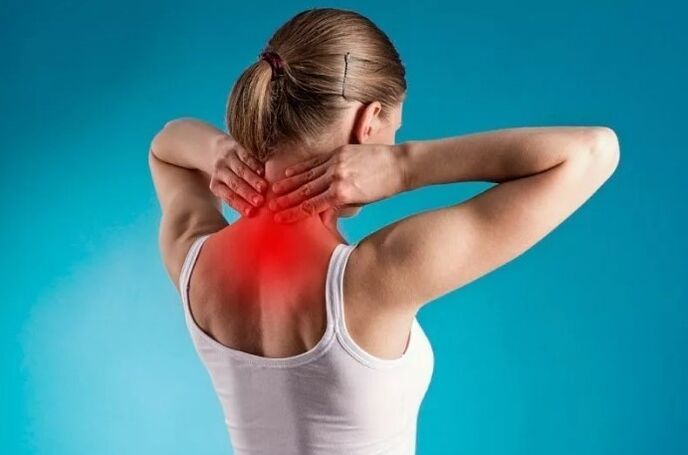Cervical osteochondrosis is the progressive distribution and deigenerative lesion of intervertebral discs in the area of 1-7 vertebrae that belong to the cervical region.
As a result of cervical osteochondrosis, deformation, exhaustion and then damage to vertebral bodies. This interrupts the normal blood supply and nerve conductivity in the neck and in those areas that are innervated by the roots of the nerves of the cervical nerves.
Cervical osteochondrosis can be isolated or combined with osteochondrosis from other departments: lumbar and sacred.
Reasons

The causes of the distributing and degenerative changes in the intervertebral discs have not yet been studied sufficiently. The assumption that osteochondrosis is a senile confirmation phenomenon. It is even in children and adolescents.
Several factors are distinguished that predispose to the development of osteochondrosis. These include:
- Sedomer and Sedentary Lifestyle,
- Types of work sitting with a static load on the neck,
- Insufficient and insufficient physical development,
- Displastic connective tissue processes,
- violation of blood circulation in the neck,
- neck injuries,
- Scoliosis, postural defects, pillows and uncomfortable mattresses,
- Hereditary predisposition, metabolic defects.
Cervical osteochondrosis symptoms
The cervical column, due to the characteristics of the skeleton, the righteousness, as well as due to the large size of the head, is especially vulnerable to the development of osteochondrosis, the vertebrae in it are the smallest compared to other parts of the spine, and the muscle frame is not very pronounced.
The most characteristic symptom of which patients complain: pain in the cervical region. Depending on the damage zone, pain can be located
- on the necklace and shoulder;
- along the cervical column;
- On the front surface of the chest.
The pain for cervical osteochondrosis is due to the characteristics of the cervical region.
The first signs of cervical osteochondrosis are insignificant and slightly specific:
- The pain in the neck at night,
- sensation of heaviness in the head, headaches in the occipital zone,
- a feeling of numbness or tingling on the shoulders and hands,
- Cryst on the neck when turning his head, clicking on the vertebrae.

Main symptoms:
Vegetative-distonic
- Quite severe pain in the neck and, especially, in the area just below the back of the head;
- The pain occurs after a long stay in a position (for example, after sleep);
- The neck muscles are constantly tense;
- There are difficulties with the abandonment of the hand aside;
- On the affected side, the fingers are limited in the movements.
Since the vertebral arteries are compressed, neurological manifestations are observed: headache, nausea, fainting.
Spinal symptom
The pain is located behind the sternum to the left.
This type of pain must be distinguished from pain as in angina pectoralis (with angina pectoralis, nitroglycerin is relieved, with osteochondrosis - no).
With a gradual violation of the structure of the intervertebral discs, its compression (compression) occurs and the infraction of the nerve roots, as well as the narrowing or violation of the arteries and veins, which take place in the area of the vertebral bodies.
This leads to the formation of special syndromes: root and ischemic.
- The defeat of the roots of the first cervical vertebra (C1): violations affect the back of the head, reducing skin sensitivity;
- The C2 injury gives pain in the crown crown and the back of the head;
- C3 lesion gives neck pain from the infringement side, a decrease in sensitivity in the tongue and sub -language muscles, in some cases with speech disabilities and loss of control over language;
- The defeat of C4 and C5 gives shoulder and clavicle pain, a decrease in the tone of the muscles of the head and neck, hypo, respiratory disorders and heart pain;
- C6 defeat is usually, giving neck pain, forearm, to thumbs, skin sensitivity can suffer:
- The defeat C7 gives similar symptoms with neck pain, the back of the shoulder, to the back of the hand, the violation of the force of the hands and a decrease in the reflexes.
Blood circulation disorders due to the compression of the vessels in the area of the cervical vertebrae give headaches to migraine, severe dizziness, visual disability and ears in the ears, flickering flies in front of the eyes, disorders of the autonomous functions.

There may be manifestations of cardiac syndrome with compressive heart pain, lack of air and heartbeat, rhythm disorders.
Complications
The serious complications of cervical osteochondrosis are
- Protuberance of intervertebral discs with the formation of a hernia (protuberance);
- Rupture of the intervertebral disc with infringement of nerves and blood vessels, the compression of the spinal cord is possible, which can cause death;
- There may also be broadcaster (root injuries), the formation of osteophytes (spikes in the vertebrae) with a manifestation of paresis and paralysis.
Diagnosis
In the presence of previous complaints, an appeal is necessary to the orthopedic doctor or neurologist.
First, the doctor will evaluate mobility and neck pain, sensitivity and other functions. Then, radiography of the cervical column will be required in several projections, if necessary, computerized tomography or magnetic resonance scan with suspicion of hernia.
In the case of circulatory disorders, a background will be needed and a background exam.
Cervical osteochondrosis treatment
Today, there are traditional and non -traditional methods for the treatment of osteochondrosis in the cervical column.
Conservative methods are mainly used:
- Symptomatic therapy with analgesics to relieve pain syndrome
- Reception of non -steridal series anti -inflammatory drugs to relieve inflammation and tissue edema
- To eliminate muscle cramps, antispasmodics and medications are used to improve blood circulation.

In the treatment of cervical osteochondrosis, substances that restore the structure of intervertebral discs are used: condoprotectors.
The course of group B vitamins is shown, external products for therapy are applicable: gels and ointments, creams with anti -inflammatory and analgesic components. Sams stimulating the regeneration of intervertebral discs.
The general massage, acupuncture, physioception, physiotherapy and gymnastics and gymnastics helps in the treatment of osteochondrosis. The osteopathy method has demonstrated well: a slight effect on the "subject" areas of the muscles and vertebrae.
In the treatment of cervical osteochondrosis, the use of a special necklace (Shantsa necklace) is recommended.
The complications of cervical osteochondrosis with hernias that violate sensitivity and blood circulation can be treated quickly.
The duration of treatment depends on the negligence of the condition, since osteochondrosis is a progressive chronic disease. The treatment can be long and preventive courses are performed for life.
Proper nutrition will help relieve the condition of osteochondrosis.
Exercises for the treatment of cervical osteochondrosis:
- Autojuncto: In a position with a straight back, it is necessary to lower the shoulders as low as possible, while the neck should be lying. It is necessary to make at least 10 approaches at least 3 times a day.
- Auto -Massage: Grace the neck with a towel, taking it by the ends and take it alternately, extending the neck muscles. In this case, it is necessary to ensure that the towel does not slide along the neck.
- Gymnastics are shown for the cervical region for osteochondrosis: small neck flexion, as well as turns and head inclination. At the same time, 5-7 inclinations are carried out in each direction. This exercise is more useful for performing after the self -insazage of the cervical column.
Prevention
The health base of the cervical column is a strong and healthy back, physical activity, a comfortable bed with pillows and anatomical mattresses, adequate posture and adequate nutrition.
It is worth avoiding neck injuries and weightlifting. It is necessary to combine a prolonged session with rest and warm periods.























